These are poor quality shots but they include two interesting behaviors from two different species so I thought they were worth a look-see.
There are multiple reasons for the poor quality – initially the birds were far away, they were side-lit, some aren’t very sharp, the damned power lines got in the way and operator error may have played a part. I won’t be including image techs because these were grab shots and they weren’t particularly appropriate for the situation anyway.
Two weeks ago I stopped along a road for a minute or so to see how the Red-tailed Hawks chicks were doing in a nest on a power pole I’ve been watching all spring. Soon the male of the pair (I believe it’s the male) took off from another power pole down the line and headed toward the nest with a vole for the chicks. At first I was just watching him through my lens without taking any shots because he was so far away and the light angle was poor. But when a pugnacious little Western Kingbird started beating up on the hawk I instinctively fired away.
I saw the kingbird strike the hawk three times and the raptor recoiled each time (here he has his nictitating membrane closed to protect his eye from injury). For one series of images the kingbird was actually riding on the back of the hawk.
In this shot the hawk is transferring the vole from his beak to his right foot although most of that process is hidden from view by the damned power line.
Here the transfer has been completed.
The kingbird was persistent in its attack…
which made the hawks flight erratic as he tried to fly with the awkward vole, react to and threaten the kingbird and avoid the multiple wires that were in his path. Eventually the kingbird veered off…
and left the hawk which allowed him to make his approach to the nest without interference from the diminutive but feisty songbird. Here the hawk has his eye on the nest on the pole directly in front of and just above him.
Kingbirds are fearless little fighters when defending their nesting territory and this one demonstrated clearly why they’re called kingbirds and their genus name is Tyrannus (tyrant). And I have to wonder why the hawk transferred the vole from beak to talons – was it typical of this bird to do it just before he landed on the nest with food? Or was it so he’d have his beak free to threaten and scream at the kingbird in flight? I just don’t know…
Because of their poor quality I very nearly deleted these images and early on I certainly never considered posting them. But over the last two weeks I kept coming back to them because I was so interested in the behaviors of both birds so I finally relented because I thought that if I found them interesting others might too.
Ron


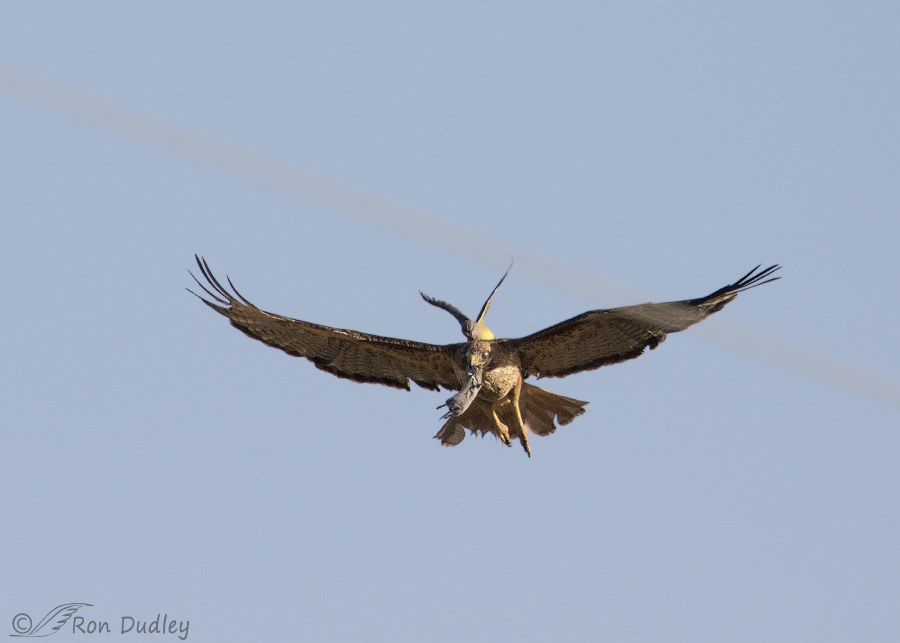

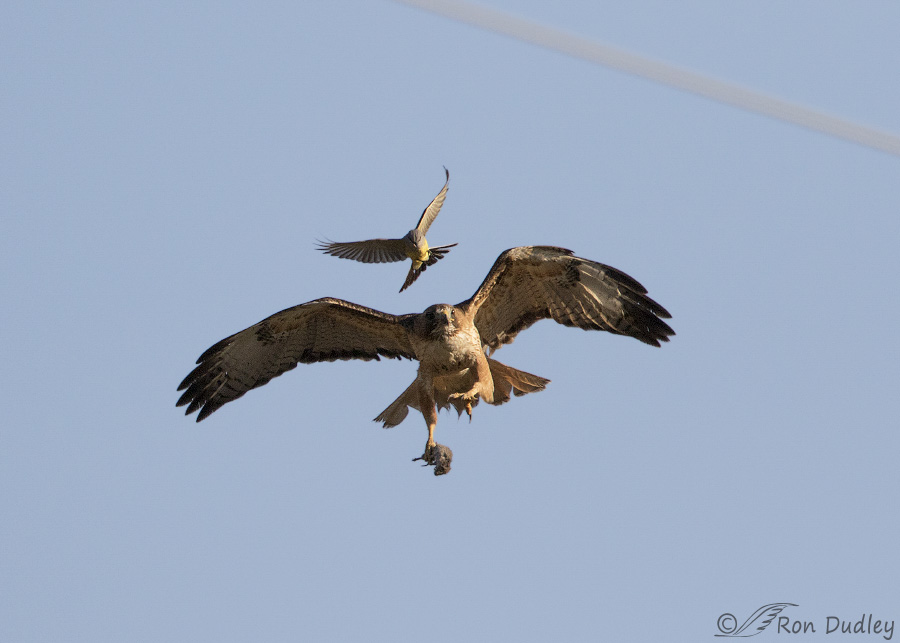
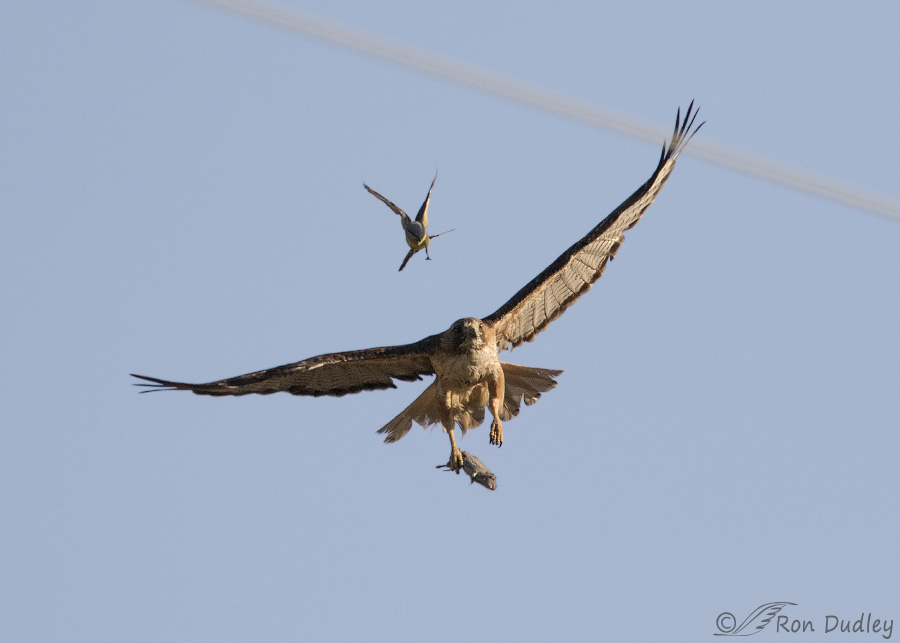
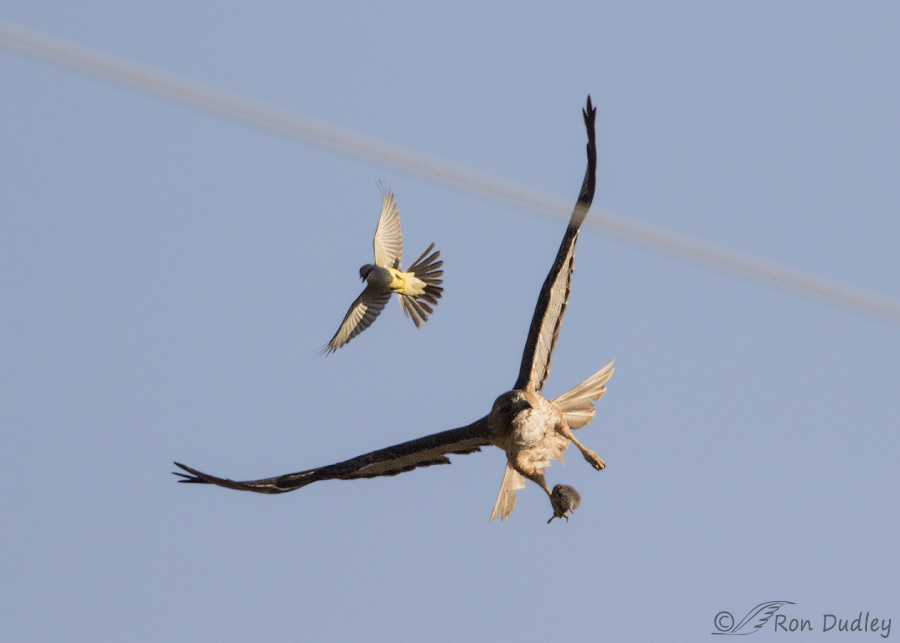
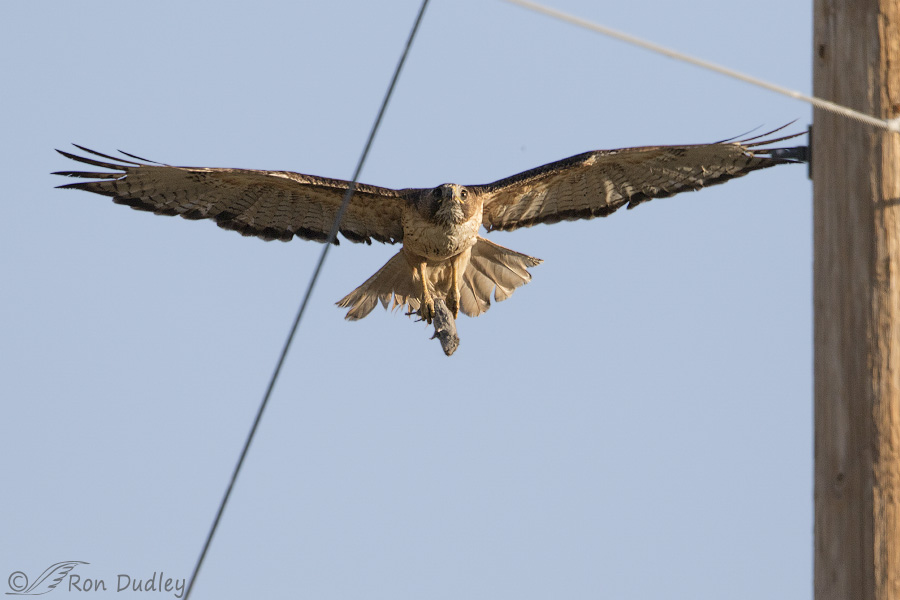
Oh WOW! To my eye, these are spectacular shots from a behavioral point of view. So they’re not perfect technologically. Meh! Not a problem!
I’m hideously late to this post and I apologize, but I’ve got a few things to add to the discussion. About 10 years ago (roughly) I saw this happen in real time. I couldn’t believe my eyes and of course I don’t have a photo…DUH! (LOL) Since then, I’ve collected photos from others on the Internet and another taken by a friend when a scissor-tailed flycatcher attacked her falconry Cooper’s hawk! Given the odds of a) being out in the field when this happens to catch the act, b) being there with the appropriate camera equipment, c) the ability to use it and d) all that combined with the ability to use the camera when your jaw is dropped onto the ground, I figure this happens a lot more frequently in The Great Out There than we humans think!
Thanks so much for being there with all those factors in place! You ROCK!
Wow, Amazing.
I enjoyed this series too. How about a crow riding a bald eagle: http://www.audubon.org/news/why-would-crow-ride-eagle
Your title says it all and the photos show it all.
I’ve never seen an Eastern Kingbird ride a raptor but the red-winged blackbirds do it all the time. I usually feel sorry for the raptor because it seems like they can’t fly anywhere without getting harassed. I’ve seen dozens of the male red-wings go after an eagle. Last weekend a red-tail was screaming at the crows who were pulling its tail. Getting food to the raptor chicks is challenging even after a successful hunt.
So glad you did not delete! Thank you for sharing!
Thank you, Shelley.
What an amazing scene. I have been impressed (more than once) with feisty birds who punch well above their weight and loved seeing it today. KINGbird indeed.
Thank you so much for posting the series.
Unlike some species kingbirds are appropriately named, EC. Thanks.
What great timing. I have never seen that, and we have both types of the birds here. Always learning something. 🙂
It happens most often during nesting season, Jean. Keep watchful and you might see it too.
Holy cow! Now that’s an eventful series and yes, it’s a very good thing you decided to share and not delete. What a rare opportunity to see a behavior I’d bet many of us can’t even imagine happens without the aid of Photoshop — a songbird riding the back of a hawk! Thanks for posting, Ron. One question: this is a different hawk nest from the one you’ve reported on more recently, yes? So even more opportunities for chick pix, I hope!
Chris, yes it’s a different nest. This one is on a power pole and the other one is on the side of a cliff. Thank you.
Step away from the delete key! 😉
These are some pretty fantastic shots regardless of light and image quality. I understand your hesitation because of those issues and that makes me appreciate the share even more.
Thank you, Marty.
Well away from the delete key.
Please.
Or allow some of us to ‘dumpster-dive’ in it and recover the treasures you discard.
🙂
WOW!!! What are the chances of seeing much less capturing something like this!!! So often you seem to be in the right place at the right time…and I know it isn’t just luck, but dedication, persistance, skill, chocolate donuts and coffee!!! The size difference is impressive as is the determination and courage of the smaller bird…instincts can sure get you in a lot of trouble…
Patty, Lately I’ve been trying to go easy on the chocolate donuts but my craving for them is almost instinctual so yes – instincts can be troublesome sometimes! 🙂
I know what you mean. I was face to face with my arch-donut (glazed raspberry jelly) on Saturday and it took a lot to walk away.
Wow wow wow! Ron this is amazing! I watch this kind of behavior daily with the crows, and it is always heart stopping to me because the crows are fierce, and the hawk is screaming at them, but 3 crows dive taking turns and it seems so cruel but they are protecting their nesting site which is very close to the hawks! It still makes me nervous for both the crows and hawk. It is hard for me to watch because I love crows and hawks. Nature sure can be violent!
Barby, Around here I see more ravens harassing raptors than crows but it must be quite similar.
So glad you decided to post these shots – the fierceness with which animals protect their nesting places brings out the mama bear in me! Both these birds were being parents and that little exchange you caught makes me think of all kinds of human behaviors when we are taking care of our kids. It’s not just little birds who can be belligerent. Gotta love that kingbird, but I’m also glad the hawk didn’t drop the food he worked hard to get for his own family.
Yup, it’s almost universal among most species to protect your youngsters at any cost. Thanks, Kathleen.
These are definitely interesting images. And about those wires – at least they aren’t the one thing in the photo that’s sharp (that’s how it would be if it were my photo). I’m glad you posted these images. It’s good to be able to see these kinds of behaviors, which I think most of us would never otherwise see.
Thank you, Susan.
Fantastic post, Ron! I’m with all the others–extremely glad you didn’t delete them. I find them thrilling. I’ve seen kingbirds chase osprey, echoing their every move, but have never seen anything even close to this. Landing on and riding on the back of the red-tailed hawk, and a hawk with prey none the less, is over the top! I’m so glad you were there to capture the moments and thank you for sharing them with us.
I thought it was pretty special too, Sharon – despite the image quality. Thank you.
You’ve got to be kidding! These are the best behavioral shots I’ve EVER SEEN! CONGRATS!!!
Charlotte
Thanks very much, Charlotte.
Hurrah for behavior shots!!! Regardless of the techs involved I think these are fantastic.
My take, is that the transfer allowed his head, back of neck and beak flexibility to defend himself without losing the vole.
The second picture looks like the Kingbird is right on the back of the head of the hawk, but probably more on its neck. I would think losing the vole was more important to secure. The hawk instinctively knows their talons are more secure than their beak. Just my idea.
And your idea is very possibly spot on, Dick. Thanks.
I’m amazed by these photos, regardless of light quality, i’m glad you didn’t delete them and instead decided to share them with us. Thank you!
I appreciate that, Elmer.
These may not be the best shots, but they’re sure interesting. Glad you decided to share.
Thank you, Ann. I’m glad you enjoyed the series.
The temerity of that little bird! I enjoyed this because it got my imagination fired up. Morning!
Kingbirds are the epitome of ATTITUDE, Arwen. I love them for that.
WOW! Glad you didn’t delete the shots as they certainly show the action! 🙂 Many small birds are pretty feisty giving both hawks and magpies something to think about! 🙂 I’m guessing the hawk wanted it’s beak free in hopes of giving the king bird something to think about! 🙂 At least the hawk didn’t lose the vole in the process………….
“At least the hawk didn’t lose the vole in the process”
I’ve seen that happen more than once in these situations, Judy.
Will a raptor go back and fetch up a lost bit of prey? Or can they only ‘see’ it if it’s moving? Great series, Ron. What a belligerent little bird!
I’ve seen them do both, Philina – go back and retrieve it and abandon it.